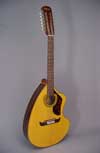

This is my 1970 model Giannini CraViola 12 string guitar. Well it's not exactly a guitar. It is a CraViola. I purchased this new from Ray Lammar's Music in Cincinnati, Ohio. I must have been 16 or 17 years old at the time.
Giannini Guitars or Tranquillo Giannini Guitars are the largest manufacturer of guitars in Brazil, South America. They still manufacture guitars as well as other plectrum instruments in their San Paulo factory.
In 1890 a gifted woodworker named Tranquillo Giannini traveled from his native Italy to Brazil to explore its treasure of exotic woods. He was so impressed by the remarkable abundance, variety, and quality of timbers, some of which are unique to the region, that he never left. Settling in downtown Sao Paulo, he established a workshop primarily for making furniture, but as a hobby he built guitars for his friends in his spare time.
Giannini guitars were (and are) made by the Tranquilo Giannini S.A. factory, Carlos Weber 124, Sao Paolo, Brazil. They are generally known for being well-made instruments featuring very fancy Brazilian hardwood veneers, as well as for the strange-shaped asymmetrical CraViola models. Three CraViolas were offered. These had a strange asymmetrical shape with a pear shape, no waist on the bass side and sharp waist (and almost cutaway taper) on the treble. Soundholes were D-shaped with fancy rosettes, with a pointed tortoise guard on the steel-stringed versions. These had slotheads with a Woody Woodpecker-like peak pointed bassward. The bridges were similar to the mustache version on the Country Western. The CRA6N Classic ($150) had a yellow spruce top and full-grained Brazilian rosewood body, no inlays or pickguard. The CRA6S Steel String ($160) was a similar steel-string with pin bridge and diamond inlays. The CRA12S 12 String ($175) was the 12-string version.
The CraViola's model was designed for Paulinho Nogueira, the Toquinho's teacher, who played and composed with Tom Jobim and Vinícius de Moraes. These instruments were created in 1970 during a time when the harpsichord was prevalent in popular music. It's designer sought to build an instrument that would produce a sound that was a cross between a harpsichord and the viola caipira which is a 10-string folk guitar that is used in Spanish American music. The viola caipira has 5 courses of strings tuned in unison. Whereas the Craviola has 12 strings. The top two courses are tuned in unison and the bottom four courses are tuned in octaves. With this instrument, the builder felt that the player could add the harpsichord sound to popular Spanish music. To distinguish from the American 12 string guitar, he called it a CraViola. The Portuguese word "cravo" means harpsichord. It is derived from the Italian "clavaciembela" or English "clavichord" which was a smaller version of the harpsichord. The viola comes from the aforementioned South American instrument.
By today's standards, this guitar would not be considered worthy since it is made of laminated wood. Giannini now offers several contemporary models of CraViola including a handmade 6 string. The shapes of the new models are slightly updated. The sound holes no longer sport the D shape. The headstocks no longer have the pointed beak and are no longer the slothead design of classical guitars, but now have solid headstocks. Gone too is the mustache bridge. This was replaced with a more contemporary design. The new models have been updated to solid wood and all come with built in electronics.
My Craviola 12 string has a very bright but subdued sound. It's neck is wide, but comfortable. The strings sit low enough to be a pleasure to play. For a while it was my trademark guitar.
No comments:
Post a Comment